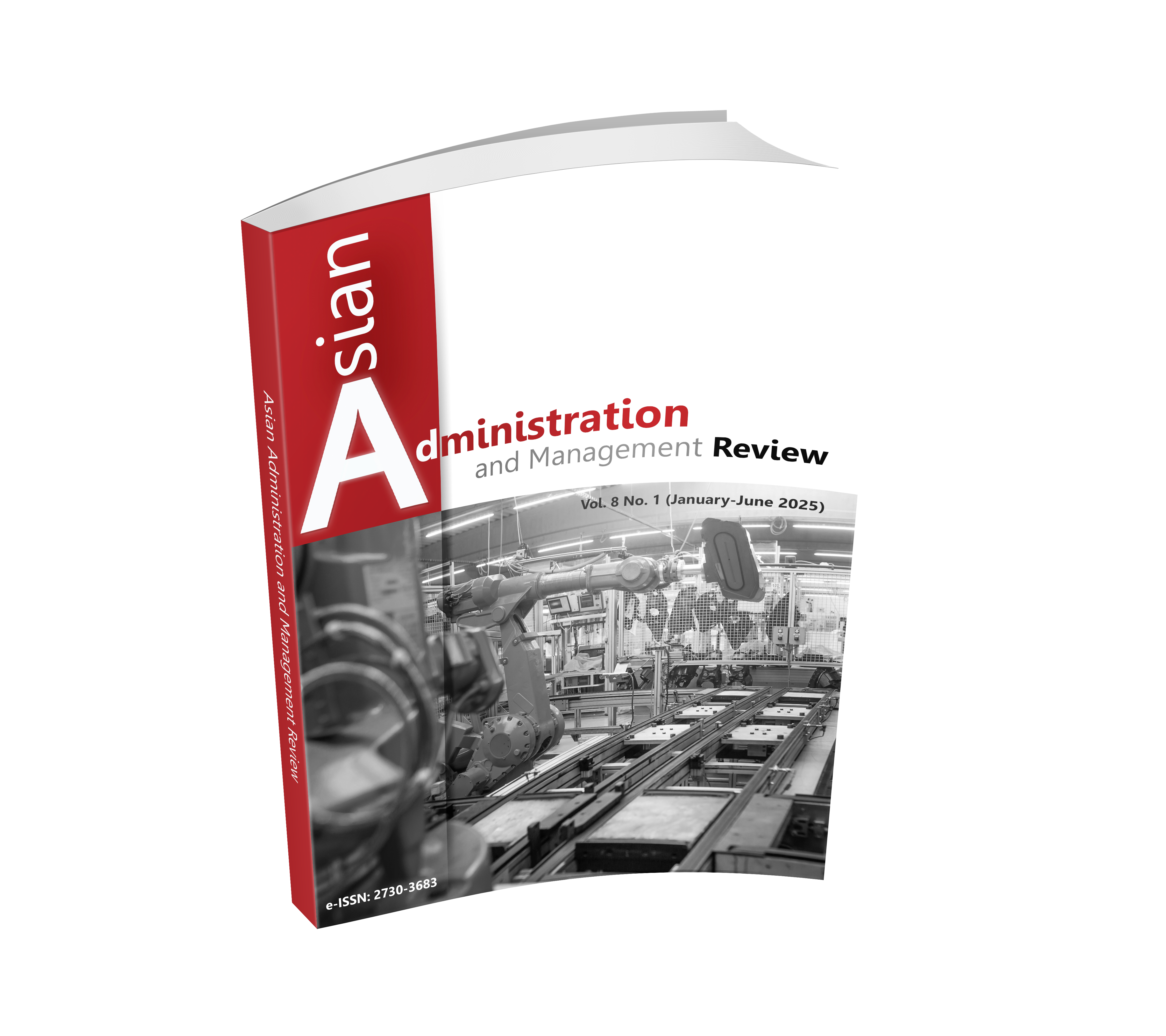ENVIRONMENTAL UNCERTAINTY AND BUSINESS MODEL OF SATO SADED-NUM BUSINESS IN YALA, THAILAND
DOI:
https://doi.org/10.14456/aamr.2025.7Keywords:
Environmental Uncertainty, Business Model, Sato Saded-Num, Yala ProvinceAbstract
This study aimed to analyze the environmental uncertainty and business models of the Sato Saded-Num (Parkia Speiosa Hassk) business in Yala, Thailand. The sample included farmers, collectors, and processors/entrepreneurs involved in a research project that conducts economic activities related to Sato in five districts of Yala. Qualitative data was collected through structured interviews based on a business model framework. Environmental uncertainty was analyzed quantitatively, while business goals, issues, and development needs were analyzed qualitatively using frequency and percentage analysis. The Sato business model was analyzed qualitatively through content analysis. Three groups were identified based on environmental uncertainty: high demand and supply uncertainty, low supply and high demand uncertainty, and low demand and supply uncertainty. Business goals across these groups centered on five Sato product types: fresh, frozen, chilled, dried, and seasoned Sato. Most entrepreneurs focused on long pods/fresh Sator and peeled, halved, and frozen Sato. The primary challenges identified were customer acquisition and aligning product value propositions with market demands. The analysis resulted in a business model centered around peeled, fresh, and chilled Sato (OEM), emphasizing the value of fresh, peeled Sato. A checklist can be used to identify uncertainties that can be leveraged to align the business model with its context better.
Downloads
References
Ahumada, O., & Villalobos, J. (2011). Operational model for planning the harvest and distribution of perishable agricultural products. International Journal of Production Economics, 133(2), 677-687.
Athanasopoulou, A., & De Reuver, M. (2020). How do business model tools facilitate business model exploration? Evidence from action research. Electronic Markets, 30, 495-508.
Brillinger, A., Els, C., Schäfer, B., & Bender, B. (2020). Business model risk and uncertainty factors: Toward building and maintaining profitable and sustainable business models. Business Horizons, 63(1), 121-130.
Chen, H., Zeng, S., Lin, H., & Ma, H. (2017). Munificence, Dynamism, and Complexity: How Industry Context Drives Corporate Sustainability. Business Strategy and the Environment, 26(2), 125-141.
Chenhall, R. (2003). Management control systems design within its organizational context: Findings from contingency-based research and directions for the future. Accounting, Organizations and Society, 28(2-3), 127-168.
Cortimiglia, M., Ghezzi, A., & Frank, A. (2016). Business model innovation and strategy making nexus: Evidence from a cross-industry mixed-methods study. R&D Management, 46(3), 414-432.
Fissi, S., Romolini, A., & Gori, E. (2020). Building a business model for a new form of hospitality: The albergo diffuso. International Journal of Contemporary Hospitality Management, 32(1), 307-323.
Freudenreich, B., Lüdeke-Freund, F., & Schaltegger, S. (2020). A Stakeholder Theory Perspective on Business Models: Value Creation for Sustainability. Journal of Business Ethics, 166, 3-18.
Fricz, Á., Ittzés, A., Ózsvári, L., Szakos, D., & Kasza, G. (2020). Consumer perception of local food products in Hungary. British Food Journal, 122(9), 2965-2979.
Ganbold, O., & Matsui, Y. (2017). Impact of Environmental Uncertainty on Supply Chain Integration. The Journal of Japanese Operations Management and Strategy, 7(1), 37-56.
Jangga, R., Ali, N., Ismail, M., & Sahari, N. (2015). Effect of Environmental Uncertainty and Supply Chain Flexibility Towards Supply Chain Innovation: An exploratory Study. Procedia Economics and Finance, 31, 262-268.
Kajanus, M., Iire, A., Eskelinen, T., Heinonen, M., & Hansen, E. (2014). Business model design: new tools for business systems innovation. Scandinavian Journal of Forest Research, 29(6), 603-614.
Kim, Y., & Park, J. (2021). A Structural Relationship Between Environmental Uncertainty, Dynamic Capability, and Business Performance in a Smart Supply Chain Environment. In J. Kim, & R. Lee. (eds.). Data Science and Digital Transformation in the Fourth Industrial Revolution (pp. 13-24). Cham: Springer.
Klimanov, D., & Tretyak, O. (2019). Linking business model research and marketing: New network-based approach to business model analysis. Journal of Business & Industrial Marketing, 34(1), 117-136.
Li, S., & Lin, B. (2006). Accessing information sharing and information quality in supply chain management. Decision Support Systems, 42(3), 1641-1656.
Niemimaa, M., Järveläinen, J., Heikkilä, M., & Heikkilä, J. (2019). Business continuity of business models: Evaluating the resilience of business models for contingencies. International Journal of Information Management, 49, 208-216.
Nyström, A., & Mustonen, M. (2017). The dynamic approach to business models. AMS Review, 7, 123-137.
Ojala, A. (2016). Business models and opportunity creation: How IT entrepreneurs create and develop business models under uncertainty. Information Systems Journal, 26(5), 451-476.
Osterwalder, A., & Pigneur, Y. (2010). Business Model Generation. New Jersey: John Wiley & Sons.
Parnell, J., Long, Z., & Lester, D. (2015). Competitive strategy, capabilities and uncertainty in small and medium sized enterprises (SMEs) in China and the United States. Management Decision, 53(2), 402-431.
Paulraj, A., & Chen, I. (2007). Environmental Uncertainty and Strategic Supply Management: A Resource Dependence Perspective and Performance Implications. Journal of Supply Chain Management, 43(3), 29-42.
Sachsenhofer, W. (2016). Leveraging Business Model Components as Drivers of Business Model Portfolios. Journal of Business Models, 4(3), 37-47.
Saputra, N., Sasanti, N., Alamsjah, F., & Sadeli, F. (2022). Strategic role of digital capability on business agility during COVID-19 era. Procedia Computer Science, 197, 326-335.
Schneckenberg, D., Velamuri, V., Comberg, C., & Spieth, P. (2017). Business model innovation and decision making: Uncovering mechanisms for coping with uncertainty. R&D Management, 47(3), 404-419.
Siaw, C., & Sarpong, D. (2021). Dynamic exchange capabilities for value co-creation in ecosystems. Journal of Business Research, 134, 493-506.
Sun, B., & Liu, Y. (2021). Business model designs, big data analytics capabilities and new product development performance: Evidence from China. European Journal of Innovation Management, 24(4), 1162-1183.
Syed, T., Blome, C., & Papadopoulos, T. (2020). Resolving paradoxes in IT success through IT ambidexterity: The moderating role of uncertain environments. Information & Management, 57(6), 103345.
Taylor, D., & Fearne, A. (2009). Demand management in fresh food value chains: A framework for analysis and improvement. Supply Chain Management, 14(5), 379-392.
Teece, D. (2018). Business models and dynamic capabilities. Long Range Planning, 51(1), 40-49.
Veiga, P., Marnoto, S., Guerra-Mota, M., & Rexhepi, G. (2024). Building new business models in MSMEs: digital capabilities, global value chains integration and the moderating role of entrepreneurial failure. Journal of Small Business and Enterprise Development, 31(3), 492-514.
Wahl, M., & Prause, G. (2013). Toward understanding resources, competencies, and capabilities: business model generation approach. Entrepreneurship and Sustainability Issues, 1(2), 67-80.
Wang, L., Yeung, J., & Zhang, M. (2011). The impact of trust and contract on innovation performance: The moderating role of environmental uncertainty. International Journal of Production Economics, 134(1), 114-122.
Yasir, M., & Majid, A. (2017). Entrepreneurial knowledge and start-up behavior in a turbulent environment. Journal of Management Development, 36(9), 1149-1159.

Downloads
Published
How to Cite
Issue
Section
License
Copyright (c) 2025 Authors

This work is licensed under a Creative Commons Attribution-NonCommercial-NoDerivatives 4.0 International License.











.png)


